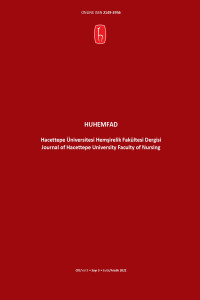Abstract
Amaç: Araştırma, epilepsili çocuklarda tamamlayıcı ve integratif tedavi kullanım yaygınlığını ve kullanılan yöntemleri belirlemek amacıyla yapılmıştır.
Gereç ve Yöntem:Bu kesitsel tip araştırmaya, epilepsi tanılı çocukların ebeveynleri (294 ebeveyn) katıldı.
Bulgular: Araştırmada çocukların yaş ortalaması 7.75±3.30 olup, ebeveynlerin tamamlayıcı ve integratif tedavi kullanım sıklığı %62.9’du. En yaygın bildirilen tamamlayıcı ve integratif tedavi türü dua ve muska takma (%90) idi. Bunu sarımsak ve süt karışımı (%31.6), özel diyet (%16.6), bal (%15.0), psikolojik görüşmeler (%10.5) ve kekik suyu (%9.4) izledi. Tamamlayıcı ve integratif tedavi kullanımı ile anlamlı olarak ilişkili olan faktörler; 12 ve üzeri yaş (DOO 19.06, 95% GA 3.39-107.15), düşük sosyoekonomik durum (DOO 10.91, 95% GA 1.89-62.84), orta sosyoekonomik durum (DOO 7.05, 95% GA 1.37-36.23), ailede epilepsi öyküsü (DOO 2.15, 95% GA 1.13-4.08), yılda 1 kereden az nöbet geçirme (DOO 3.50, 95% GA 1.25-9.81) ve eşlik eden en az bir hastalık (DOO 2.54, 95% GA 1.16-5.58) olmasıdır (p<0.05).
Sonuç: Epilepsili çocuklarda tamamlayıcı ve integratif tedavi yaygın olarak kullanılmaktadır. Tedavinin etkinliği için ebeveynlerin tamamlayıcı ve integratif tedavi yöntemlerinin belirlenmesi gereklidir.
Abstract
Aim: The research was conducted to determine the prevalence of complementary and integrative therapy use in children with epilepsy and the methods used.
Material and Methods: Parents (294 parents) of children diagnosed with epilepsy participated in this cross-sectional study.
Results: In the study, the mean age of the children was 7.75±3.30, and the frequency of use of complementary and integrative therapy by the parents was 62.9%. The most commonly reported complementary and integrative treatment type was prayer and wearing amulets (90.0%). This was followed by a mixture of garlic and milk (31.6%), special diet (16.6%), honey (15.0%), psychological interviews (10.5%), and thyme juice (9.4%). Factors that were significantly associated with the use of complementary and integrative therapy were age 12 and over (AOR 19.06, 95% CI 3.39-107.15), low socioeconomic status (AOR10.91, 95% CI 1.89-62.84), moderate socioeconomic status (AOR 7.05, 95% CI 1.37-36.23), family history of epilepsy (AOR 2.15, 95% CI 1.13-4.08), seizure less than once a year (AOR 3.50, 95% CI 1.25-9.81), and at least one concomitant disease (AOR 2.54, 95% CI 1.16-5.58) (p<0.05).
Conclusion: Complementary and integrative therapy are widely used in children with epilepsy. For the effectiveness of the treatment, it is necessary to determine the parents' complementary and integrative treatment methods.
Details
| Primary Language | Turkish |
|---|---|
| Subjects | Health Care Administration |
| Journal Section | Research Article |
| Authors | |
| Publication Date | January 6, 2023 |
| Submission Date | December 17, 2021 |
| Published in Issue | Year 2022 Volume: 9 Issue: 3 |


